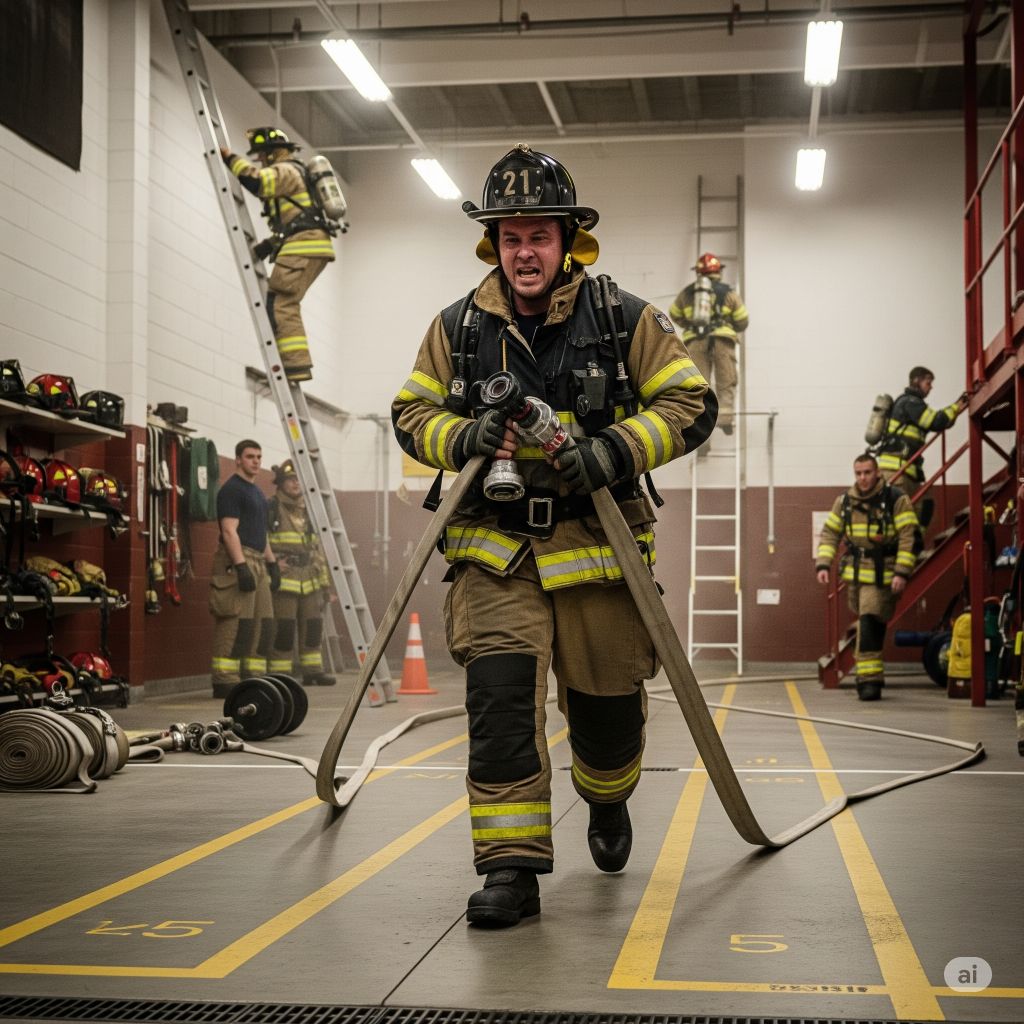
As a firefighter, staying in peak physical condition is crucial for the job. The firefighter fitness test is a rigorous assessment designed to ensure that firefighters are ready to handle the physical demands of the job. From endurance to strength, this test covers all the essential aspects of fitness needed to excel in the field.
In my experience, preparing for the firefighter fitness test requires dedication and a well-rounded training regimen. As I share insights and tips on how to ace this test, you’ll discover the importance of cardiovascular endurance, strength training, and flexibility in meeting the challenges of the test. Stay tuned to learn how to crush the firefighter fitness test and excel in your firefighting career.
Key Takeaways
- Firefighter fitness tests are crucial for ensuring safety, job performance, and effective teamwork within a firefighting team.
- Components of the test include cardiovascular endurance, strength and power, flexibility, core stability, agility and coordination, and overall physical fitness.
- Cardiovascular endurance training is essential for maintaining a steady heart rate and delivering oxygen efficiently during physically demanding tasks.
- Strength training focusing on functional movements, core strength, upper body strength, and lower body strength is vital for enhancing performance in firefighting scenarios.
- Incorporating flexibility and mobility exercises into your routine is crucial for optimal performance, reducing injury risks, and enhancing overall functional capacity as a firefighter.
Importance of Firefighter Fitness Test
Being physically fit is essential in a firefighter’s line of work. The firefighter fitness test plays a crucial role in ensuring that firefighters are prepared to handle the demanding tasks they face on the job. Here’s why the firefighter fitness test is so important:
- Safety: A firefighter’s physical condition can directly impact their safety and the safety of others. Being fit ensures that firefighters can perform their duties effectively and with a reduced risk of injury.
- Job Performance: Firefighters often need to work in high-stress situations that require physical strength, endurance, and agility. A good level of fitness can enhance job performance and the ability to respond efficiently to emergencies.
- Teamwork: Firefighting is a team effort, and each member must be able to rely on one another. Completing the firefighter fitness test ensures that every firefighter is capable of fulfilling their role within the team effectively.
Maintaining peak physical condition through the firefighter fitness test is not just about meeting standards—it’s about being prepared for the unexpected challenges that come with the job.
Components of the Test
When it comes to the firefighter fitness test, there are several key components that individuals need to pass. These components are carefully designed to assess different aspects of physical readiness and ensure that firefighters are prepared for the challenges they may encounter on the job. Here are some of the common components you can expect to find in a firefighter fitness test:
- Cardiovascular Endurance: This component typically involves activities such as running, cycling, or stair climbing to evaluate how well firefighters can sustain physical effort over an extended period.
- Strength and Power: Firefighters need to have strong muscles to carry equipment, move debris, and perform rescues. Tests may include exercises like push-ups, sit-ups, and weightlifting to evaluate strength and power.
- Flexibility: Flexibility is crucial for firefighters to maneuver through tight spaces, perform tasks that require bending or stretching, and reduce the risk of injuries. Stretching exercises are commonly included in the test to assess flexibility levels.
- Core Stability: A strong core is essential for firefighters to maintain balance, stability, and prevent injuries during physically demanding tasks. Tests to evaluate core strength often include planks, bridges, and other core-strengthening exercises.
- Agility and Coordination: Firefighters must navigate through complex environments quickly and effectively. Tests for agility and coordination may include obstacle courses, ladder drills, or other exercises that mimic real-life firefighting scenarios.
- Overall Physical Fitness: In addition to these specific components, the firefighter fitness test generally aims to assess an individual’s overall physical fitness level to ensure they can perform well in various firefighting situations.
So, it’s important for individuals aspiring to become firefighters to prepare themselves physically and mentally for these diverse components of the firefighter fitness test.
Cardiovascular Endurance Training
When it comes to acing the firefighter fitness test, cardiovascular endurance plays a crucial role. I ensure that I incorporate a mix of aerobic exercises like running, cycling, and swimming into my workout routine. It’s essential to push myself to the limit, as the test will assess my ability to maintain a steady heart rate and deliver oxygen efficiently to my muscles during physically demanding tasks.
In preparation, I focus on interval training to boost my cardiovascular fitness. Training in intervals helps improve my endurance levels and prepares me for the bursts of energy required during emergencies. High-intensity interval training (HIIT) is a key component of my workout regimen, as it simulates the intensity of firefighting scenarios and enhances my overall performance.
Moreover, I emphasize cross-training to target different muscle groups and prevent overuse injuries. By incorporating activities like circuit training and rowing into my routine, I not only enhance my cardiovascular health but also strengthen my muscles and improve my overall physical preparedness for the test.
To excel in the cardiovascular endurance component of the firefighter fitness test, I push myself beyond my limits, incorporating a variety of training methods to build a strong foundation of cardiovascular fitness for the challenges ahead.
Strength Training for Firefighters
When it comes to excelling in the firefighter fitness test, strength training plays a crucial role alongside cardiovascular endurance. In firefighting scenarios, firefighters often encounter physically demanding tasks that require muscular strength and power. Incorporating strength training exercises into your workout routine can significantly enhance your performance and overall readiness for the challenges ahead.
Here are some key points to consider when it comes to strength training for firefighters:
- Functional movements: Focus on exercises that mimic the movements required in firefighting situations, such as carrying equipment, lifting heavy objects, and climbing stairs. Incorporating squats, lunges, deadlifts, and push-ups can help build functional strength.
- Core strength: A strong core is essential for maintaining proper posture, stability, and balance during firefighting tasks. Include exercises like planks, Russian twists, and leg raises to strengthen your core muscles.
- Upper body strength: Firefighters often need to perform tasks that involve the upper body, such as lifting hoses, breaching doors, and carrying victims. To enhance upper body strength, include exercises like pull-ups, rows, bench presses, and shoulder presses in your workout routine.
- Lower body strength: Strong legs are paramount for tasks that involve running, climbing, and lifting. Incorporate exercises like squats, lunges, calf raises, and deadlifts to strengthen your lower body muscles.
By incorporating a well-rounded strength training regimen into your overall fitness routine, you can build the physical strength and power needed to perform effectively in firefighting situations. Remember to progressively overload your muscles, maintain proper form, and listen to your body to prevent injuries and optimize your training outcomes.
Flexibility and Mobility Exercises
When it comes to excelling in the Firefighter Fitness Test, flexibility and mobility play crucial roles in ensuring optimal performance and reducing the risk of injuries. As a firefighter, I know firsthand the importance of being able to move freely and maintain a full range of motion in various exercises and scenarios.
Incorporating regular stretching routines into your workout regimen can help improve flexibility and prevent muscle tightness. Focus on dynamic stretches that mimic movements you’ll encounter during firefighting tasks to prepare your body effectively. I recommend incorporating exercises like leg swings, arm circles, and hip rotations to warm up and enhance flexibility before your training sessions.
Moreover, mobility exercises are essential for maintaining proper joint function and range of motion. As a firefighter, it’s vital to have the agility to navigate through confined spaces and perform tasks that require flexibility and coordination. Including exercises such as shoulder dislocations, hip openers, and spinal twists can help enhance your overall mobility and functional capacity.
Prioritizing flexibility and mobility will not only improve your performance during the Firefighter Fitness Test but also enhance your ability to carry out job-related duties effectively. By dedicating time to these aspects of fitness, you’ll be better equipped to handle the physical demands of firefighting and respond efficiently to emergency situations.
Conclusion
Ensuring optimal flexibility and mobility is key to excelling in the Firefighter Fitness Test. By incorporating a mix of flexibility exercises and mobility drills like leg swings and arm circles into your routine, you can boost agility and functional capacity. These exercises not only enhance performance during the test but also prepare you for the physical demands of emergency situations. Remember, maintaining proper joint function and a full range of motion is crucial for reducing injury risks and performing at your best. Prioritize flexibility and mobility training to elevate your performance and readiness as a firefighter.
Frequently Asked Questions
Why is flexibility important for excelling in the Firefighter Fitness Test?
Flexibility is crucial for firefighters as it helps maintain a full range of motion, improves joint function, and reduces the risk of injuries. Incorporating stretching and mobility exercises can enhance agility, functional capacity, and overall performance during the test.
What types of mobility exercises are beneficial for firefighters preparing for the Fitness Test?
Mobility exercises like leg swings, arm circles, and shoulder dislocations are highly advantageous for firefighters. These exercises improve joint mobility, enhance flexibility, and contribute to better agility and readiness for the physical demands of firefighting tasks.
How frequently should firefighters incorporate flexibility and mobility exercises into their training routine?
It is recommended for firefighters to perform flexibility and mobility exercises regularly. Incorporating these exercises into daily or at least 3-4 times a week can help maintain flexibility, improve joint function, and optimize performance during the Fitness Test and emergency situations.
Can prioritizing flexibility and mobility exercises also help prevent injuries among firefighters?
Yes, prioritizing flexibility and mobility exercises can significantly reduce the risk of injuries among firefighters. By improving flexibility and joint function, firefighters can enhance their overall physical readiness, agility, and resilience, thereby lowering the likelihood of injuries during demanding tasks and emergency scenarios.
